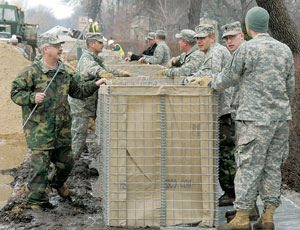Citizens of Fargo, N.D., and neighboring Moorhead, Minn., appear to have dodged another bullet, but only after an heroic, all-hands effort in late March in advance of floodwaters that ultimately surpassed a 1997 record flood. With little more than a week’s notice, an army of federal, state and local resources, along with sandbag-packing volunteers, built a maze of temporary dikes atop existing levees to withstand the onslaught of the rising Red River.

At ENR press time, floodwaters in Fargo were slowly receding from a record crest of 40.82 ft on March 28, and it appears that the area has escaped major flooding. Officials were optimistic that the worst was over and that—barring a significant levee failure as the Red River recedes over the next few weeks—Fargo would be spared the economic devastation experienced by Iowa cities last summer and by Grand Forks, N.D., in 1997.
Fargo Mayor Dennis Walaker says the town avoided devastation due to a combination of small but crucial flood-control projects after the 1997 flood, as well as an extremely quick mobilization in advance of this flood. Virtually the entire levee system was raised in about seven days, using millions of sandbags, 38 miles of 4-ft HESCO barriers and other temporary measures. “We did it in a fourth of the time we had in 1997,” he says. “We had tremendous support from the federal government, the National Guard, the state and local government all the way down to our citizens and volunteers.”
By beating the 1997 flood, Fargo succeeded not only in protecting its property but also in hindering subsequent funding for flood protection. In the 1997 floods, Fargo “won by 3 in.” but subsequently lost out in the competition for funding with the city of Grand Forks, which was devastated by the 1997 flood and went on to receive massive funding for permanent upgrades, Walaker says.
In late April 1997, the river crested at 40.1 ft, and a similar heroic effort saved Fargo. Farther downstream, Grand Forks was devastated when temporary levees were overtopped and the entire city flooded. More than 8,000 homes were lost. Economic damage was estimated at $3.6 billion, according to an after-action report, “Living With the Red,” published in November 2000 by The Joint Commission, a U.S./Canadian group formed to analyze and make recommendations on the Red River after the 1997 floods.
The devastation of Grand Forks crystallized state and local support for a comprehensive flood-control program. Since 1997, Grand Forks had a $417-million program for new levees, floodwalls and improved pumping systems. Funding was 45% federal, 20% state and 35% local, according to Grand Forks officials.
High and Dry
As Fargo fought for its life in late March, a Grand Forks newspaper ran a feature titled “High and Dry” about the city’s change in fortune. After the 1997 floods, plans were developed for a $161-million upgrade for Fargo, but local opposition and a lack of funding stalled it. “Because we were successful in avoiding the flood, we were basically told to stand in line,” says Walaker, a civil engineer who was the city’s public-works director in 1997 and who was elected mayor in 2006. The inability to get consensus and funding was “frustrating to say the least,” he says. “We’re hoping that this time, with all the focus on Fargo, we’ll get some national attention.”
The latest round of flooding underscores the tough choices faced by local officials in known flood zones in the U.S. With federal funding scarce, local funds even scarcer and local opposition to flood-control measures a barrier to action, it typically takes a devastating event to create consensus and sources of funding, says Gerald Galloway, a University of Maryland professor and leader in national flood-control analysis. A reactive approach that funds projects based on emotion does not serve the national interest well, he says. “We need to bring a rational, comprehensive approach to the problem,” he explains. “As a nation we need to discover where the economic risks are greatest and prioritize.”

Post a comment to this article
Report Abusive Comment